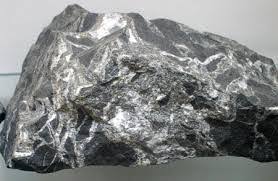
Zinc ores are minerals and rocks containing sufficient zinc in the amount efficient for their profitable processing. More than ninety-nine percent (99%) of zinc deposits found in the earth's crust occur in the form of sphalerite, or zinc blende, which is the main ore for zinc.
It contains roughly 60-63% content of zinc which is why it is the most heavily and commonly mined ore with zinc content throughout the globe. Apart from sphalerite, there are also minor zinc sulfide-containing ores which include wurtzite, zinc silicate-containing ore known as hemimorphite, and zinc carbonate ores such as smithsonite and hydrozincite.
Zinc is the 4th most widely used metal after iron, aluminum, and copper. It is a chemical element with the symbol Zn and atomic number 30, it has a melting point of 419.5 °C and a boiling point of 907 °C.
Zinc is mainly used in the production of galvanized steel, which widely used in automobiles, home appliances, construction, infrastructure, ships, light industry, machinery, and batteries.
Demand for galvanized steel is highly dependent on investments in the construction, infrastructure, and automobiles industries. In addition, zinc consumption in batteries for energy storage is also advancing, as its manufacturing is inexpensive compared to other batteries.
After increasing marginally in 2019, global zinc consumption decreased in 2020, due to falling demand from key end-user markets. Global finished steel demand is expected to recover in 2021 with improvements in the manufacturing, automotive, construction and infrastructure sectors.
The main driver of growth will be China, followed by India, the US and Germany. Over the forecast period, the global zinc consumption is expected to grow by 2025, with a rebound in the construction and automotive industries.
The automotive sector is one of the major consumers of zinc. The automotive industry recovered in early 2021, with key automotive players such as Tesla, General Motors and Ford all registering strong sales and actively ramping up operations in the country.
This also serves as another factor for the growth of the zinc market over the forecast period (2020-2025).
The construction industry makes extensive use of galvanized steel for the roofing and cladding of commercial and industrial buildings. Supported by various investment projects, the market is expected to increase.
Nigeria is one of the West African countries with Zinc deposits, and the mineral-rich states in no particular order include Anambra, Ebonyi, Plateau, Cross Rivers, Zamfara, Abuja (FCT), Enugu, Imo, Kano, Niger, and Taraba. It is estimated that Nigeria has over ten million (10,000,000) tons of zinc ore deposit.
The Nigerian Customs Service (NCS) has revealed that a total of forty-nine thousand, eight hundred and sixty-eight (49,868) tonnes of lead were exported between 2013 and 2017, while thirty thousand, seven hundred and sixty-eight (30,768) tonnes of zinc were similarly exported within the same period.
The Minister of Mines and Steel Development, Alhaji Abubakar Bawa Bwari, disclosed this at a groundbreaking and foundation laying ceremony of the Lead & Zinc processing plant in Ebonyi State.
In 2020 the top importers of Zinc Ore were China ($2.12B), South Korea ($1.14B), Belgium ($596M), Canada ($591M), and Spain ($572M).
After declining substantially in 2016, global zinc production increased in both 2017 and 2018, reaching thirteen million, two hundred thousand (13,200,000) metric tons and thirteen million, four hundred thousand (13,400,000) metric tons respectively.
However, the global market still remains sluggish and has been in a severe deficit since 2016, impacted by several mine closures and production cuts over prices concerns.
In 2018, although global zinc supply increased by one point five percent (1.5%) to thirteen million, four hundred thousand (13,400,000) metric tons, it was still short, by one million, one hundred thousand (1,100,000) metric tons, of the global demand of fourteen million, five hundred thousand (14,500,000) metric tons in that year.
Increases in demand of one point six percent (1.6%), two point two percent (2.2%), one point seven percent (1.7%), and three point two percent (3.2%) from China, Germany, the US, and Belgium, respectively, were the major factors behind the increase in the global demand.
These offset the growth in global output originating from MMG’s Dugald River project, the commissioning of Century Resource’s New Century mine and the Hellyer tailings project in Australia, as well as a few smaller mines commencing operations across the globe.
Over the forecast period (2019–2022), global zinc supply is expected to grow at a compound annual growth rate of three point eight percent (3.8%), to fifteen million, seven hundred thousand (15,700,000) metric tons in 2022.
Simultaneously, the gap between demand and supply is expected to narrow and eventually the market will move into a surplus in 2022.
This will be due to almost one hundred (100) new projects commencing operations between 2019 and 2022 where zinc is either a primary or a secondary commodity being produced.






















